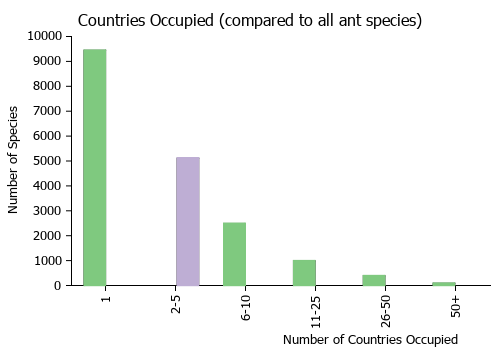Formica orangea
| Formica orangea | |
|---|---|

| |
| Scientific classification | |
| Kingdom: | Animalia |
| Phylum: | Arthropoda |
| Class: | Insecta |
| Order: | Hymenoptera |
| Family: | Formicidae |
| Subfamily: | Formicinae |
| Tribe: | Formicini |
| Genus: | Formica |
| Species: | F. orangea |
| Binomial name | |
| Formica orangea Seifert & Schultz, 2009 | |
Prefers dry steppe and semidesert habitats, in the vicinity of rivers or lakes. Invades rural areas and gardens. Nests found in moderately dry sand, often with characteristic slant gateways leading to the underground. Foraging on available trees, probably tending trophobionts. (Seifert and Schultz 2009)
Identification
Seifert and Schultz (2009) - A member of the Formica rufibarbis group. Formica orangea shows an unmistakable combination of orange colour, short head, short scape, high interocellar distance, low pronotal setae numbers and large microripple distance on gaster tergites.
Keys including this Species
Distribution
Seifert and Schultz (2009) - Occurring in the Oriental-Turanian and Central Asian floristic region of the south submeridional and meridional zones. Ranging from 58° (Iran) to 104° E (Mongolia) and 34° (Afghanistan) to 48° N (Kazakhstan) at elevations between 400 and 2200 m.
Latitudinal Distribution Pattern
Latitudinal Range: 47.711° to 34.41°.
| North Temperate |
North Subtropical |
Tropical | South Subtropical |
South Temperate |
- Source: AntMaps
Distribution based on Regional Taxon Lists
Palaearctic Region: Afghanistan, Kyrgyzstan (type locality), Uzbekistan.
Distribution based on AntMaps
Distribution based on AntWeb specimens
Check data from AntWeb
Countries Occupied
| Number of countries occupied by this species based on AntWiki Regional Taxon Lists. In general, fewer countries occupied indicates a narrower range, while more countries indicates a more widespread species. |

|
Estimated Abundance
| Relative abundance based on number of AntMaps records per species (this species within the purple bar). Fewer records (to the left) indicates a less abundant/encountered species while more records (to the right) indicates more abundant/encountered species. |

|
Biology
Castes
Worker
Images from AntWeb
   
| |
| Holotype of Formica orangea. Worker. Specimen code antweb1008418. Photographer Roland Schultz, uploaded by California Academy of Sciences. | Owned by SMNG, Görlitz, Germany. |
Nomenclature
The following information is derived from Barry Bolton's Online Catalogue of the Ants of the World.
- orangea. Formica orangea Seifert & Schultz, 2009: 266, fig. 6 (w.) KYRGIZSTAN.
Unless otherwise noted the text for the remainder of this section is reported from the publication that includes the original description.
Description
Worker
Medium-sized Serviformica species (CS 1.349 mm), head short (CL / CW1.4 1.111), scape shortest and distance of lateral ocelli largest within the Formica rufibarbis group (SL / CS1.4 1.021, OceD / CS1.4 0.172), eye relatively small (EYE / CS1.4 0.288), petiole relatively narrow (PEW / CS1.4 0.421). Clypeus with sharp median keel and fine longitudinal microcarinulae. Frontal triangle finely transversely rippled and with 35 - 60 short pubescence hairs. Eyes with microsetae of 10 - 13 μm maximum length. Total mean of unilateral setae numbers on different body parts predicted for a specimen with CS = 1.4 mm: pronotum 1.5, mesonotum 0.8, petiole scale dorsal of spiracle 0.2, flexor profile of hind tibia 0.3. Posterior margin of head and propodeum plus dorsolateral metapleuron normally without setae. Ventral coxae and gaster tergites with long setae. Dorsal mesonotal profile broadly rounded. Metanotal depression moderately deep. Propodeal dome in profile flatly rounded to angled, the basal profile sometimes slightly concave. Dorsal crest of petiole in frontal view broadly convex. Petiole scale in lateral aspect relatively low and thicker than in other species of the F. rufibarbis group, except Formica tarimica sp.n., with convex anterior and straight to slightly convex posterior profile. Gaster with transverse microripples of rather large distance (RipD 6.7 μm, second largest within the F. rufibarbis group) and covered by dense silvery pubescence (sqPDG 3.15). Pubescence on head, mesosoma and petiole less dense. Whole head, mesosoma, coxae, all appendages, and petiole in typical cases reddish yellow; sometimes in smaller specimens brown spots may occur on posterior vertex and dorsal promesonotum, but always with low contrast between the pigmented and the light parts, gaster always brown.
Type Material
Holotype worker plus 4 worker paratypes labelled “KIR:41.8327°N,71.1948°E Tshatkal valley, 1830 m R.Schultz 1998.07.28-115” and “Holotype Formica orangea Seifert & Schultz” / “Paratype Formica orangea Seifert & Schultz”, 5 paratype workers in ethanol, SMN Görlitz; from the same nest series: 3 mounted paratype workers and 19 paratype workers in ethanol, coll. RS.
Etymology
From the mainly orange body color.
References
- Seifert, B. and R. Schultz. 2009b. A taxonomic revision of the Formica rufibarbis Fabricius, 1793 group (Hymenoptera: Formicidae). Myrmecologische Nachrichten. 12:255-272.
- Borowiec, L. 2014. Catalogue of ants of Europe, the Mediterranean Basin and adjacent regions (Hymenoptera: Formicidae). Genus (Wroclaw) 25(1-2): 1-340.
- Borowiec, M.L., Cover, S.P., Rabeling, C. 2021. The evolution of social parasitism in Formica ants revealed by a global phylogeny. Proceedings of the National Academy of Sciences 118, e2026029118 (doi:10.1073/pnas.2026029118).
References based on Global Ant Biodiversity Informatics
- Borowiec L. 2014. Catalogue of ants of Europe, the Mediterranean Basin and adjacent regions (Hymenoptera: Formicidae). Genus (Wroclaw) 25(1-2): 1-340.
- Guénard B., and R. R. Dunn. 2012. A checklist of the ants of China. Zootaxa 3558: 1-77.
- Seifert B., and R. Schultz. 2009. A taxonomic revision of the Formica rufibarbis Fabricius, 1793 group (Hymenoptera: Formicidae). Myrmecological News 12:255-272.

